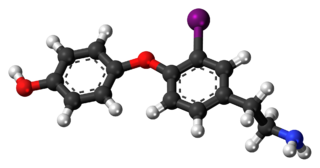
Insulin-like growth factor 1 (IGF-1), also called somatomedin C, is a hormone similar in molecular structure to insulin which plays an important role in childhood growth, and has anabolic effects in adults. In the 1950s IGF-1 was called "sulfation factor" because it stimulated sulfation of cartilage in vitro, and in the 1970s due to its effects it was termed "nonsuppressible insulin-like activity" (NSILA).

Incretins are a group of metabolic hormones that stimulate a decrease in blood glucose levels. Incretins are released after eating and augment the secretion of insulin released from pancreatic beta cells of the islets of Langerhans by a blood-glucose–dependent mechanism.

3-Iodothyronamine (T1AM) is an endogenous thyronamine. It is a high-affinity ligand of the trace amine-associated receptor 1 (TAAR1). T1AM is the most potent endogenous TAAR1 agonist yet discovered. It is also an agonist of the TAAR2 and TAAR5 with similar potency as for the TAAR1 (all in the case of the human proteins). T1AM is not a ligand of the thyroid hormone receptors. However, it is additionally a ligand of various monoamine and other receptors. For instance, it is a muscarinic acetylcholine receptor antagonist.

Glucagon-like peptide-1 (GLP-1) is a 30- or 31-amino-acid-long peptide hormone deriving from tissue-specific posttranslational processing of the proglucagon peptide. It is produced and secreted by intestinal enteroendocrine L-cells and certain neurons within the nucleus of the solitary tract in the brainstem upon food consumption. The initial product GLP-1 (1–37) is susceptible to amidation and proteolytic cleavage, which gives rise to the two truncated and equipotent biologically active forms, GLP-1 (7–36) amide and GLP-1 (7–37). Active GLP-1 protein secondary structure includes two α-helices from amino acid position 13–20 and 24–35 separated by a linker region.

The glucagon-like peptide-1 receptor (GLP1R) is a G protein-coupled receptor (GPCR) found on beta cells of the pancreas and on neurons of the brain. It is involved in the control of blood sugar level by enhancing insulin secretion. In humans it is synthesised by the gene GLP1R, which is present on chromosome 6. It is a member of the glucagon receptor family of GPCRs. GLP1R is composed of two domains, one extracellular (ECD) that binds the C-terminal helix of GLP-1, and one transmembrane (TMD) domain that binds the N-terminal region of GLP-1. In the TMD domain there is a fulcrum of polar residues that regulates the biased signaling of the receptor while the transmembrane helical boundaries and extracellular surface are a trigger for biased agonism.

The δ-opioid receptor, also known as delta opioid receptor or simply delta receptor, abbreviated DOR or DOP, is an inhibitory 7-transmembrane G-protein coupled receptor coupled to the G protein Gi/G0 and has enkephalins as its endogenous ligands. The regions of the brain where the δ-opioid receptor is largely expressed vary from species model to species model. In humans, the δ-opioid receptor is most heavily expressed in the basal ganglia and neocortical regions of the brain.

Peroxisome proliferator-activated receptor gamma, also known as the glitazone reverse insulin resistance receptor, or NR1C3 is a type II nuclear receptor functioning as a transcription factor that in humans is encoded by the PPARG gene.

Adiponectin receptor 1 (AdipoR1) is a protein which in humans is encoded by the ADIPOR1 gene. It is a member of the progestin and adipoQ receptor (PAQR) family, and is also known as PAQR1.

The muscarinic acetylcholine receptor, also known as cholinergic/acetylcholine receptor M3, or the muscarinic 3, is a muscarinic acetylcholine receptor encoded by the human gene CHRM3.

Free fatty acid receptor 1 (FFAR1), also known as G-protein coupled receptor 40 (GPR40), is a rhodopsin-like G-protein coupled receptor that is coded by the FFAR1 gene. This gene is located on the short arm of chromosome 19 at position 13.12. G protein-coupled receptors reside on their parent cells' surface membranes, bind any one of the specific set of ligands that they recognize, and thereby are activated to trigger certain responses in their parent cells. FFAR1 is a member of a small family of structurally and functionally related GPRs termed free fatty acid receptors (FFARs). This family includes at least three other FFARs viz., FFAR2, FFAR3, and FFAR4. FFARs bind and thereby are activated by certain fatty acids.

Free fatty acid receptor 2 (FFAR2), also known as G-protein coupled receptor 43 (GPR43), is a rhodopsin-like G-protein coupled receptor (GPCR) encoded by the FFAR2 gene. In humans, the FFAR2 gene is located on the long arm of chromosome 19 at position 13.12 (19q13.12).

G protein-coupled receptor 119 also known as GPR119 is a G protein-coupled receptor that in humans is encoded by the GPR119 gene.

Free Fatty acid receptor 4 (FFAR4), also termed G-protein coupled receptor 120 (GPR120), is a protein that in humans is encoded by the FFAR4 gene. This gene is located on the long arm of chromosome 10 at position 23.33. G protein-coupled receptors reside on their parent cells' surface membranes, bind any one of the specific set of ligands that they recognize, and thereby are activated to trigger certain responses in their parent cells. FFAR4 is a rhodopsin-like GPR in the broad family of GPRs which in humans are encoded by more than 800 different genes. It is also a member of a small family of structurally and functionally related GPRs that include at least three other free fatty acid receptors (FFARs) viz., FFAR1, FFAR2, and FFAR3. These four FFARs bind and thereby are activated by certain fatty acids.

Trace amine-associated receptor 1 (TAAR1) is a trace amine-associated receptor (TAAR) protein that in humans is encoded by the TAAR1 gene.

PPAR agonists are drugs which act upon the peroxisome proliferator-activated receptor. They are used for the treatment of symptoms of the metabolic syndrome, mainly for lowering triglycerides and blood sugar.
Glucagon-like peptide-1 (GLP-1) receptor agonists, also known as GLP-1 analogs, GLP-1DAs, or incretin mimetics, are a class of anorectic drugs that reduce blood sugar and energy intake by activating the GLP-1 receptor. They mimic the actions of the endogenous incretin hormone GLP-1, which is released by the gut after eating.

SKF-83,959, a synthetic benzazepine derivative used in scientific research, acts as an agonist at the D1–D2 dopamine receptor heteromer. It behaves as a full agonist at the D1 protomer and a high-affinity partial agonist at the D2 protomer. It was further shown to act as an allosteric modulator of the sigma-1 receptor. SKF-83,959 additionally inhibits sodium channels as well as delayed rectifier potassium channels. SKF-83,959 is a racemate that consists of the R-(+)- and S-(−)-enantiomers MCL-202 and MCL-201, respectively.

Tropoflavin, also known as 7,8-dihydroxyflavone (DHF), is a naturally occurring flavone found in Godmania aesculifolia, Tridax procumbens, and primula tree leaves. It has been found to act as a potent and selective small-molecule agonist of the tropomyosin receptor kinase B (TrkB), the main signaling receptor of the neurotrophin brain-derived neurotrophic factor (BDNF). Tropoflavin is both orally bioavailable and able to penetrate the blood–brain barrier. A prodrug of tropoflavin with greatly improved potency and pharmacokinetics, R13, is under development for the treatment of Alzheimer's disease.

7,8,3′-Trihydroxyflavone (7,8,3'-THF) is a flavone and small-molecule agonist of TrkB, the main receptor of brain-derived neurotrophic factor (BDNF), that was derived from tropoflavin (7,8-DHF). Relative to tropoflavin, 7,8,3'-THF is 2–3-fold more potent in vitro as a TrkB agonist. 7,3'-Dihydroxyflavone (7,3'-DHF) is also more potent than tropoflavin in vitro, indicating that a 3'-hydroxy group on the B-ring enhances TrkB agonistic activity. 7,8,3'-THF has been tested in vivo and was found to produce TrkB-dependent neuroprotective effects in mice similarly to tropoflavin.

Eutropoflavin (4'-Dimethylamino-7,8-dihydroxyflavone) is a synthetic flavone and selective small-molecule agonist of TrkB, the main receptor of brain-derived neurotrophic factor (BDNF), which was derived from structural modification of tropoflavin (7,8-DHF). Relative to tropoflavin, eutropoflavin possesses higher agonistic activity at TrkB, is significantly more potent than tropoflavin both in vitro and in vivo, and has a longer duration of action. The compound has been found to produce neuroprotective and neurogenic effects in the brain and spinal cord as well as antidepressant-like effects in animals.

















